The Education Journey: Redifining the way we learn
advertisement
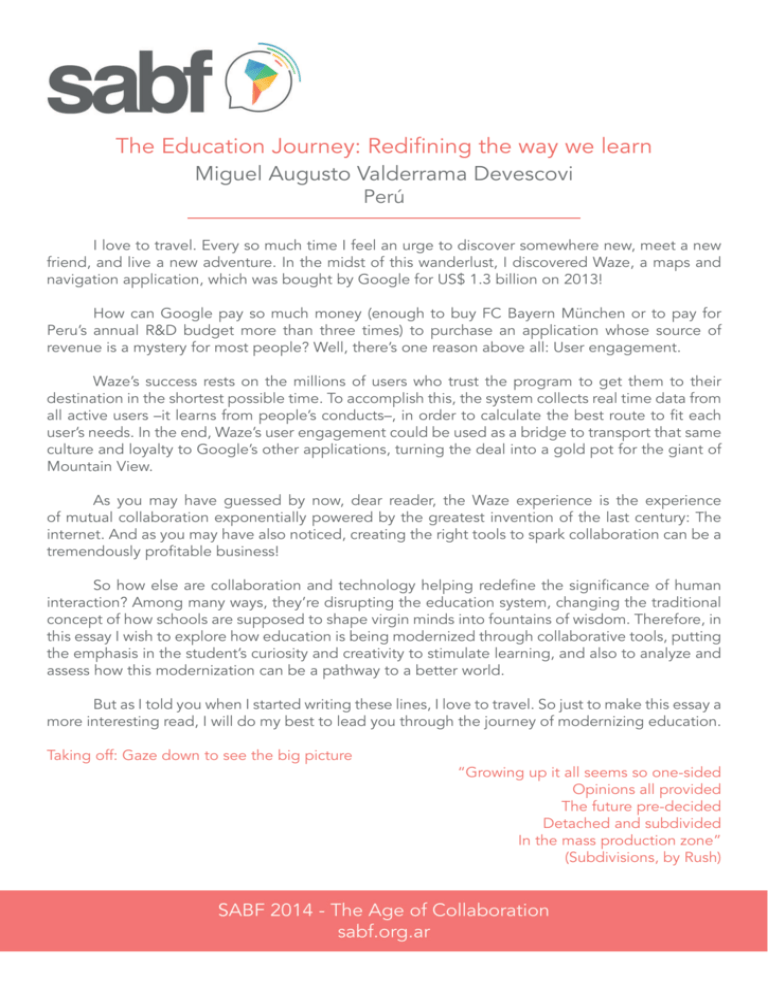
The Education Journey: Redifining the way we learn Miguel Augusto Valderrama Devescovi Perú I love to travel. Every so much time I feel an urge to discover somewhere new, meet a new friend, and live a new adventure. In the midst of this wanderlust, I discovered Waze, a maps and navigation application, which was bought by Google for US$ 1.3 billion on 2013! How can Google pay so much money (enough to buy FC Bayern München or to pay for Peru’s annual R&D budget more than three times) to purchase an application whose source of revenue is a mystery for most people? Well, there’s one reason above all: User engagement. Waze’s success rests on the millions of users who trust the program to get them to their destination in the shortest possible time. To accomplish this, the system collects real time data from all active users –it learns from people’s conducts–, in order to calculate the best route to fit each user’s needs. In the end, Waze’s user engagement could be used as a bridge to transport that same culture and loyalty to Google’s other applications, turning the deal into a gold pot for the giant of Mountain View. As you may have guessed by now, dear reader, the Waze experience is the experience of mutual collaboration exponentially powered by the greatest invention of the last century: The internet. And as you may have also noticed, creating the right tools to spark collaboration can be a tremendously profitable business! So how else are collaboration and technology helping redefine the significance of human interaction? Among many ways, they’re disrupting the education system, changing the traditional concept of how schools are supposed to shape virgin minds into fountains of wisdom. Therefore, in this essay I wish to explore how education is being modernized through collaborative tools, putting the emphasis in the student’s curiosity and creativity to stimulate learning, and also to analyze and assess how this modernization can be a pathway to a better world. But as I told you when I started writing these lines, I love to travel. So just to make this essay a more interesting read, I will do my best to lead you through the journey of modernizing education. Taking off: Gaze down to see the big picture “Growing up it all seems so one-sided Opinions all provided The future pre-decided Detached and subdivided In the mass production zone” (Subdivisions, by Rush) There are many reasons to start a journey. A breath of fresh air, a wish to discover new realms, a desire to go further. Likewise, education visionaries and entrepreneurs have been pushing the boundaries of the traditional system with the goal of improving the quality of educational services, as well as reducing the access barriers to decent education. The educator Sugata Mitra argues that the expansion of the British Empire around the globe produced a tool needed to shape the operators that would administer the Empire’s domains. This tool is the school system that we still have today, a system designed to mass-produce individuals with elemental language and mathematical abilities. Since the world has changed radically over the centuries, Mitra concludes that the school system we still have today is obsolete: not broken, but definitely outdated. This vision has opened the gates for the innovation and democratization of education we are experiencing today. Like the American entrepreneur Don Burton stated: “(…) public education hasn’t changed that much in 150 to 200 years and there had been almost no technology going into it (…). It’s not only that there’s this huge behemoth sector of the economy that spends $1.2 trillion on educating kids, but that it’s old, it’s long in the tooth and it’s bound to get disrupted.” Landing in foreign lands: Getting in touch with a different reality “There is no freedom with hunger.” (Ildefonso Falcones) Whenever I’m en-route to a new destination, I try to picture the place according to my knowledge and my expectations. If my ideas turn out to be different from reality, many times I wonder how that place could change for the better. Likewise, Alvin Toffler invites us to dream about a school that’s “open 24 hours a day. Different kids arrive at different times. They don’t all come at the same time (…). They have different potentials.” Toffler clearly evoked ideas of personalized education and technology. And if there is one aspect of social development where these advances may have a greater impact, it’s definitely among the most needed. Sadly, one of the consequences of the inequality gap, especially in less developed countries, is that frequently only poor education systems are available to for those with little resources. This creates a vicious circle that inhibits development. That’s what explains the hype created by initiatives such as Mitra’s “Hole in the Wall”, applied among children in India, who found a tool to put their curiosity and ability in action to obtain knowledge in diverse fields; or Salman Khan’s “Khan Academy”, famous for putting thousands of quality lessons in the reach of the whole world through the internet, for free. These innovative ideas have put the power to learn in the hands of students, in an attempt to break the quality gap between the capable but poor pupils and the subpar education systems available to them. I believe individual freedom is the main basic right that enables human realization. However, for many, economic conditions undermine the foundations of freedom. Applying creative methods to connect disadvantaged citizens to the market is a way to empower them and break the vicious circle of poverty. Closing the digital divide through quality, widely available education could be the single most important tool to accomplish this goal. Now, does this mean that a fully online education will become the dominant tendency for the whole world in the future? I do not think the answer is straightforward. Wandering around in (not so) distant realms: Familiarizing with the future “If your child has trouble with math but excels in languages, don’t get him a personal math teacher. Get him oratory classes!” (Miguel Angel Cornejo) As much as online-based education has proven to be a powerful weapon to fight inequality, I believe the model for the future should be a “mixed” one, with online and offline components. American educator Clayton Christensen states that “the rise of online learning carries an unprecedented opportunity to transform the schooling system into a student-centric one that can affordably customize for different student needs by allowing all students to learn at their appropriate pace and path, thereby allowing each student to realize his or her fullest potential”. This, he highlights, is the basis for a blended-learning environment. For example, the Los Altos School District in California has started using Khan Academy as a main component of its curricula, so that students can define their course of study by taking lectures online and later compliment them with workshops at school. And it’s worthy to note that these blended models are not an exclusive in developed countries. In Peru, visionaries have created modern, yet affordable, blended-education systems. A notable example is Innova Schools, which is expanding the quality education supply countrywide on the basis of an intensively technological model, where the students do intensive research while monitored in a personalized way by the teachers, who also receive permanent training in a specialized university. As I said before, I believe that blended models are the real future of education. That is because they offer affordability and adaptability, but also retain one of the key benefits of classroom education: socializing and networking. Online education can be great for cultivating the mind, but we know that intellectual prowess itself can fall short to strive through the world today. Schools are the spaces where kids and adults alike get the chance to meet hundreds of people, learn how to interact with them, and eventually make bonds that could last a lifetime. Those who argue in favor of an entirely remote, online education seem to forget this. That’s why I believe Dr. Christensen is on the right track. Reflecting Howard Garner’s multiple intelligences theory, in the end we could have a perfected model where students fully exploit the aid that teachers can give by focusing on those areas where they precisely need help, as well as in those areas in which they excel. Looking back at our pictures: How can we relive what we discovered? “Competition is the flip side of collaboration.” (Abhinav Charan) Sometimes pictures will transport us back to another place and time, and we’ll wish we could relive our greatest experiences. Likewise, now that we’ve concluded on what the future of education could be, we can ask ourselves what can be done to foster modern, inclusive education systems? Education technologies are becoming an attractive area for entrepreneurs and investors. In the USA, education technology-focused startups raised over US$ 500 million only in the first quarter of 2014. Companies like Schoology and Desire2Learn are making great business selling their products to educators, and projects such as Innova Schools have an expansive business model themselves. But what happens when we want to apply technology to benefit those who don’t have the means to pay for it? In terms of public investment, education is (or should be) essential. That’s why I invoke a wide-spread use of mechanisms to promote investment in this field. There are many tried-and-true ideas in the first world, such as the voucher system in Sweden, which seeks to generate competition between public and private schools. But what about other parts of the world? Taking Peru as an example, the Public Private Association (PPA) has become a powerful mechanism to promote socially sensitive investment by private companies, on the basis of state support and guarantees, with balanced incentives. If PPA’s have been successful to build roads and pipelines, I firmly believe they can be a gateway to the expansion of quality education. In the end, can you imagine a world where private ventures and states can cover each other’s needs, with a superlative common goal such as expanding quality education for everyone? Can you envision how much more the world could progress on the hand of bold entrepreneurs and supportive governments? Please, dream with me. But better yet, let’s put or efforts to making this dreams true, and just then we’ll know for sure that finishing a journey isn’t just appreciating the sights, it’s taking risks, it’s growing, it’s progressing. Bibliography: [1] ROTHBARD, Murray. Education: Free & Compulsory. The Ludwig von Mises Institute: Auburn (Alabama), 1999. [2] MITRA, Sugata. Build a School in the Cloud (video). Available at: http://www.youtube.com/ watch?v=y3jYVe1RGaU (last visit: 04/05/2014) [3]For more information on Innova Schools, visit their website: http://www.innovaschools.edu.pe/ [4]SHIEBER, Jordan. Education Technology Startups Raised Over Half A Billion Dollars In Q1. Available at: http://techcrunch.com/2014/03/26/education-technology-startups-raised-nearly-halfa-billion-dollars-in-q1/ (last visit: 04/05/2014) [5]FERENSTEIN, Gregory. How California’s Online Education Pilot Will End College As We Know It. Available at: http://techcrunch.com/2013/01/15/how-californias-new-online-education-pilotwill-end-college-as-we-know-it/ (last visit: 04/05/2014) [6]WATERS, Audrey. Hacking at Education: TED, Technology Entrepreneurship, Uncollege, and the Hole in the Wall. Available at: http://hackeducation.com/2013/03/03/hacking-your-educationstephens-hole-in-the-wall-mitra/ (last visit: 04/05/2014) [7]WATERS, Audrey. The Wrath Against Khan: Why Some Educators Are Questioning Khan Academy. Available at: http://www.hackeducation.com/2011/07/19/the-wrath-against-khan-whysome-educators-are-questioning-khan-academy/ (last visit: 04/05/2014) [8]BOYD, Courtney. Clayton Christensen: Why Online Education is Ready for Disruption, Now. Available at: http://thenextweb.com/insider/2011/11/13/clayton-christensen-why-onlineeducation-is-ready-for-disruption-now/ (last visit: 04/05/2014)
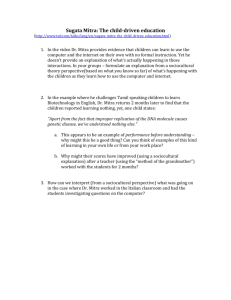
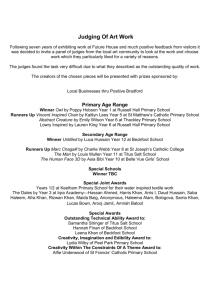
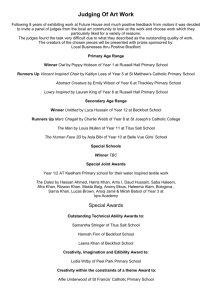


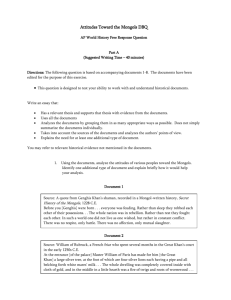
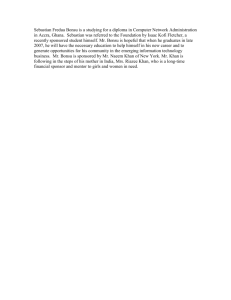
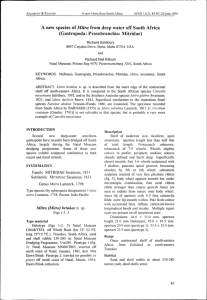
![arXiv:1508.00837v2 [cs.SI] 27 Apr 2016](http://s2.studylib.net/store/data/018725056_1-2df6d5a398de3f63ba3375893ecd9b4f-300x300.png)